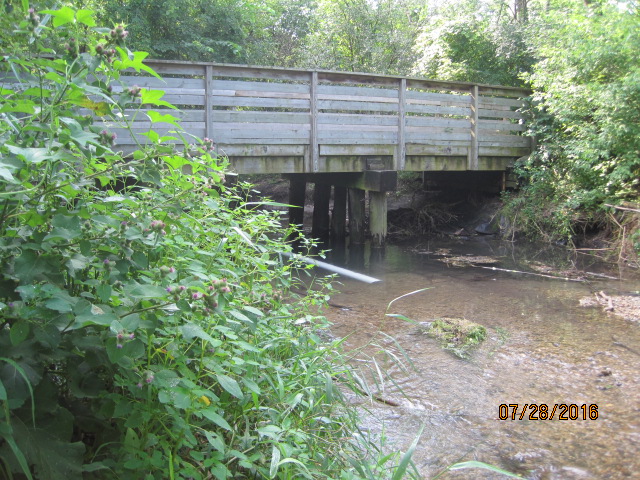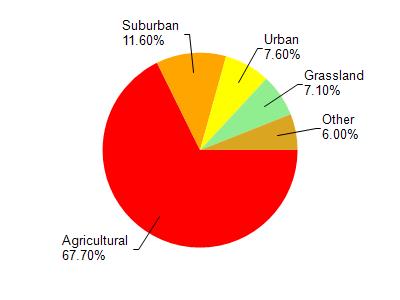
0.03 Miles
0 - 0.03
Not Determined
2025
Unknown
Recreational Restrictions - Pathogens
E. coli
Rock
No
No
Yes
Fish and Aquatic Life
Overview
drains to the Rock River at Janesville and is one of four streams of the same name in the county. This short, spring-fed stream was managed for trout into the 1950s, when stocking was discontinued due to siltation and channel modifications that destroyed habitat. The stream's watershed is intensively farmed. Spring Brook's water quality is affected by siltation from farming operations and urban runoff.
Date 2002
Author Aquatic Biologist
Historical Description
From: Ball, Joseph R., and Ronald J. Poff, Lake and Stream Classification Project. Surface Water Resources of Rock County, Department of Natural Resources, 1970.
Surface Acres = 1.82, Miles = 1.25, Gradient = 40 feet per mile.
A short spring fed stream located in the City of Janesville and tributary to the Rock River. The stream was managed for trout up to 1958 when stocking was suspended due to siltation and pollution. The present fish population is composed of forage species only. Four city parks are located along the shores and provide access to the stream.
Date 1970
Author Surface Water Inventory Of Wisconsin
General Condition
Spring Brook was assessed during the 2018 listing cycle; new total phosphorus sample data were clearly below the 2018 WisCALM listing thresholds for the Fish and Aquatic Life use. This water was meeting this designated use and was not considered impaired.
Date 2017
Author Ashley Beranek
Impaired Waters
Palmer Park Beach on Spring Brook was evaluated for bacteria in the 2022 cycle; E. coli levels were above listing thresholds as outlined in 2022 WisCALM. This beach was added to the 2022 Impaired Waters List.
Date 2022
Author Ashley Beranek
Condition
Wisconsin has over 84,000 miles of streams, 15,000 lakes and milllions of acres of wetlands. Assessing the condition of this vast amount of water is challenging. The state's water monitoring program uses a media-based, cross-program approach to analyze water condition. An updated monitoring strategy (2015-2020) is now available. Compliance with Clean Water Act fishable, swimmable standards are located in the Executive Summary of Water Condition in 2018. See also the 'monitoring and projects' tab.
Reports
Management Goals
Wisconsin's Water Quality Standards provide qualitative and quantitative goals for waters that are protective of Fishable, Swimmable conditions [Learn more]. Waters that do not meet water quality standards are considered impaired and restoration actions are planned and carried out until the water is once again fishable and swimmable
Management goals can include creation or implementation of a Total Maximum Daily Load analysis, a Nine Key Element Plan, or other restoration work, education and outreach and more. If specific recommendations exist for this water, they will be displayed below online.
Monitoring
Monitoring the condition of a river, stream, or lake includes gathering physical, chemical, biological, and habitat data. Comprehensive studies often gather all these parameters in great detail, while lighter assessment events will involve sampling physical, chemical and biological data such as macroinvertebrates. Aquatic macroinvertebrates and fish communities integrate watershed or catchment condition, providing great insight into overall ecosystem health. Chemical and habitat parameters tell researchers more about human induced problems including contaminated runoff, point source dischargers, or habitat issues that foster or limit the potential of aquatic communities to thrive in a given area. Wisconsin's Water Monitoring Strategy was recenty updated.
Grants and Management Projects
| Project Name (Click for Details) | Year Started |
|---|
|
|
Monitoring Projects
| WBIC | Official Waterbody Name | Station ID | Station Name | Earliest Fieldwork Date | Latest Fieldwork Date | View Station | View Data |
|---|
| 796800 | Spring Brook | 10031037 | Palmer Park Beach | 6/1/2010 | 8/19/2025 | Map | Data |
|

Watershed Characteristics
Spring Brook is located in the Blackhawk Creek watershed which is 108.11 mi². Land use in the watershed is primarily agricultural (67.70%), suburban (11.60%) and a mix of urban (7.60%) and other uses (13.10%). This watershed has 94.55 stream miles, 96.88 lake acres and 415.15 wetland acres.
Nonpoint Source Characteristics
This watershed is ranked Low for runoff impacts on streams, Not Ranked for runoff impacts on lakes and High for runoff impacts on groundwater and therefore has an overall rank of High. This value can be used in ranking the watershed or individual waterbodies for grant funding under state and county programs.However, all waters are affected by diffuse pollutant sources regardless of initial water quality. Applications for specific runoff projects under state or county grant programs may be pursued. For more information, go to surface water program grants.
Palmer Park Beach's natural community is not yet identified under the state’s Natural Community Determinations.
Natural communities (stream and lake natural communities) represent model results and DNR staff valiation processes that confirm or update predicted conditions based on flow and temperature modeling from historic and current landscape features and related variables. Predicated flow and temperatures for waters are associated predicated fish assemblages (communities). Biologists evaluate the model results against current survey data to determine if the modeled results are corect and whether biological indicators show water quaity degradation. This analysis is a core component of the state's resource management framework. Wisconsin's Riverine Natural Communities.